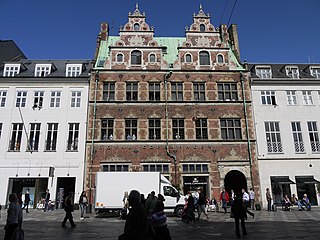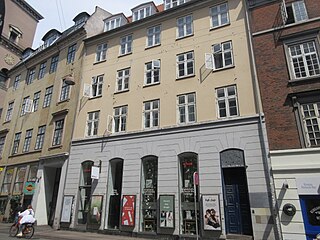
The Matthias Hansen House, formerly also known as the Schoustrup House, is a Renaissance-style townhouse on Amagertorv in central Copenhagen, Denmark. Built in 1616, it is one of few buildings of its kind which has survived the Copenhagen Fires of 1728 and 1795. The building is now home to a flagship store for the Royal Copenhagen porcelain factory.

Selsø is a historic manor house located near Skibby, on the Hornsherred peninsula, Frederikssund Municipality, some 50 km (31 mi) west of Copenhagen, Denmark. The estate traces its history back to the 13th century. The current main building dates from 1576 but was renovated in the Baroque style in 1734. The estate has been owned by the Scheel-Plessen family since 1721 but the recently restored main building and its immediate surroundings have been ceded to a self-owning foundation. The building is now operated as a museum and is also used as a venue for concerts and other events. The knight's hall is decorated with paintings by Hendrick Krock. The main building, a gatehouse from 1734 and the east wing of the adjacent home farm (Avlsgården) were listed on the Danish registry of protected buildings and places in 1918.

St Ib's Church is a Romanesque church in Roskilde on the Danish island of Zealand. It was first mentioned in 1291. The church was once richly decorated with frescos.

The Suhr House is a listed Neoclassical property located at Gammeltorv 22 in central Copenhagen, Denmark. The site has been owned by the Suhr family since 1749. The current buildings was built for Peter Bernt Suhr and are now owned by Den Suhrske Stiftelse, a family trust created by his son Theodor Suhr.

Bonderup, also known as Bonderupgård, is a manor house located 16 kilometres (9.9 mi) south of Holbæk, Denmark. Nonderup and nearby Merløsegaard were purchased by the merchant Johannes Theodorus Suhr in 1852 and is now owned by the Suhr Family Trust. Bånderup and Merløse have a combined area of 1m310 hectares.

The Rhode House is a historic property located at the corner of Strandgade and Torvegade in the Christianshavn neighbourhood of central Copenhagen, Denmark.

Nyhavn 1 is an 18th-century property at the acute corner of Nyhavn with Store Strandstræde in central Copenhagen, Denmark. It was listed in the Danish registry of protected buildings and places in 1987. Notable former residents include actor and singer Peter Schram (1819–1895).

Meyercrones Stiftelse is a historic building located just north of Roskilde Cathedral in central Roskilde, Denmark. It was listed on the Danish registry of protected buildings and places by the Danish Heritage Agency on 15 February 1978.
Aagaard is a manor house and estate located at Gørlev, Kalundborg Municipality, 100 kilometres west of Copenhagen, Denmark. It was established in 1660 by treasurer Henrik Müller and has since 1865 been owned by members of the Hellemann family. The main building was listed on the Danish registry of protected buildings and places in 1945.

The Danish Constituent Assembly is the name given to the 1848 Constitutional assembly at Christiansborg Palace in Copenhagen that approved the Danish Constitution and formalized the transition from absolute monarchy to constitutional democracy. It consisted of members of which 114 were elected by the people, 38 were appointed by the king and the rest were government ministers.
Merløsegaard is a manor house located 9 kilometres north of Ringsted, close to the village of Store Merløse, Holbæk Municipality, some sixty kilometres southwest of Copenhagen, Denmark. Merløsegaard and nearby Bonderup are owned by Den Suhrske Stiftelse. The buildings are now operated as a hotel and event venue.

Kattrup is a manor house and estate located south of Jyderyp, Kalundborg Municipality, 90 kilometres west of Copenhagen, Denmark.

Vestergade 1 is a Neoclassical property located at the corner of Gammeltorv and the street Vestergade in the Old Town of Copenhagen, Denmark. The facade towards Gammeltorv and Vestergade meet in an Obtuse angle with four bays towards the square and five bays towards the street. The building was listed in the Danish registry of protected buildings and places in 1950. Café Gammel Torv, a traditional Danish lunch restaurant, has since 1910 been based in the basement at Gammeltorv 20. The building/restaurant is now colloquially known as The House With The Green Tree after an eponymous 1942 novel by Kalvin Lindemann.

Klosterstræde 23 is a Neoclassical property in the Old Town of Copenhagen, Denmark. The building is located opposite Gråbrødrestræde, a short street linking Klosterstræde with Gråbrødretorv. The building was listed on the Danish registry of protected buildings and places in 1950.

Kompagnistræde 12 is a Neoclassical property situated on the shopping street Strædet, between Badstuestræde and Knabrostræde, in the Old Town of Copenhagen, Denmark. Like most of the other buildings in the area, it was constructed as part of the rebuilding of the city following the Copenhagen Fire of 1795. The building was listed in the Danish registry of protected buildings and places in 1964. C. E. Fritzsche, a glass shop with roots dating back to 1788, is now based in the building.

Nørregade 4 is an early 19th-century property situated in Nørregade, between Frue Plads and Gammeltorv, in the Old Town of Copenhagen, Denmark. The building was listed in the Danish registry of protected buildings and places in 1945.

Rasmus Hansen Lange was a Danish Supreme Court attorney, councilman, hospital director and developer. The listed properties at Skindergade 44 and Kompagnistræde 8 in Copenhagen were both built for him. He was a member of Knud Lyne Rahbek's social circle.

Krigsråd Mørks Minde, situated at Lille Kannikestræde 4, is a charity with affordable accommodation for widows and unmarried women from the higher classes in Copenhagen, Denmark, established by Emilie Henriette Mørk (Mørch) in 1864–65 in memory of her father, Claudius Mørch, who was awarded the title of krigsråd. The Neoclassical building was constructed by master mason Christian Aagaard in 1830–31. It was listed in the Danish registry of protected buildings and places in 1950. Notable former residents include actor Ludvig Phister, cookbook writer Anne Marie Mangor, painter Emil Carlsen and Professor Nicolai Christopher Kall Rasmussen.
Vesterbygaard is a manor house and estate situated north of Tissø, Kalundborg Municipality, some 70 km west of Copenhagen, Denmark. The three-winged main building was constructed for Christen Andreas Fonnesbech in the 1840s. The estate is still owned by his descendants. The estate covers 327 hectares of farmland.

Nyhavn 17 is a late 17th-century building situated at the corner of Nyhavn and Lille Strandstræde in central Copenhagen, Denmark. It was listed on the Danish registry of protected buildings and places in 1951. Tattoo-Ole, a tattoo shop located in the basement, claims to be the oldest still functioning tattoo shop in the world.



















